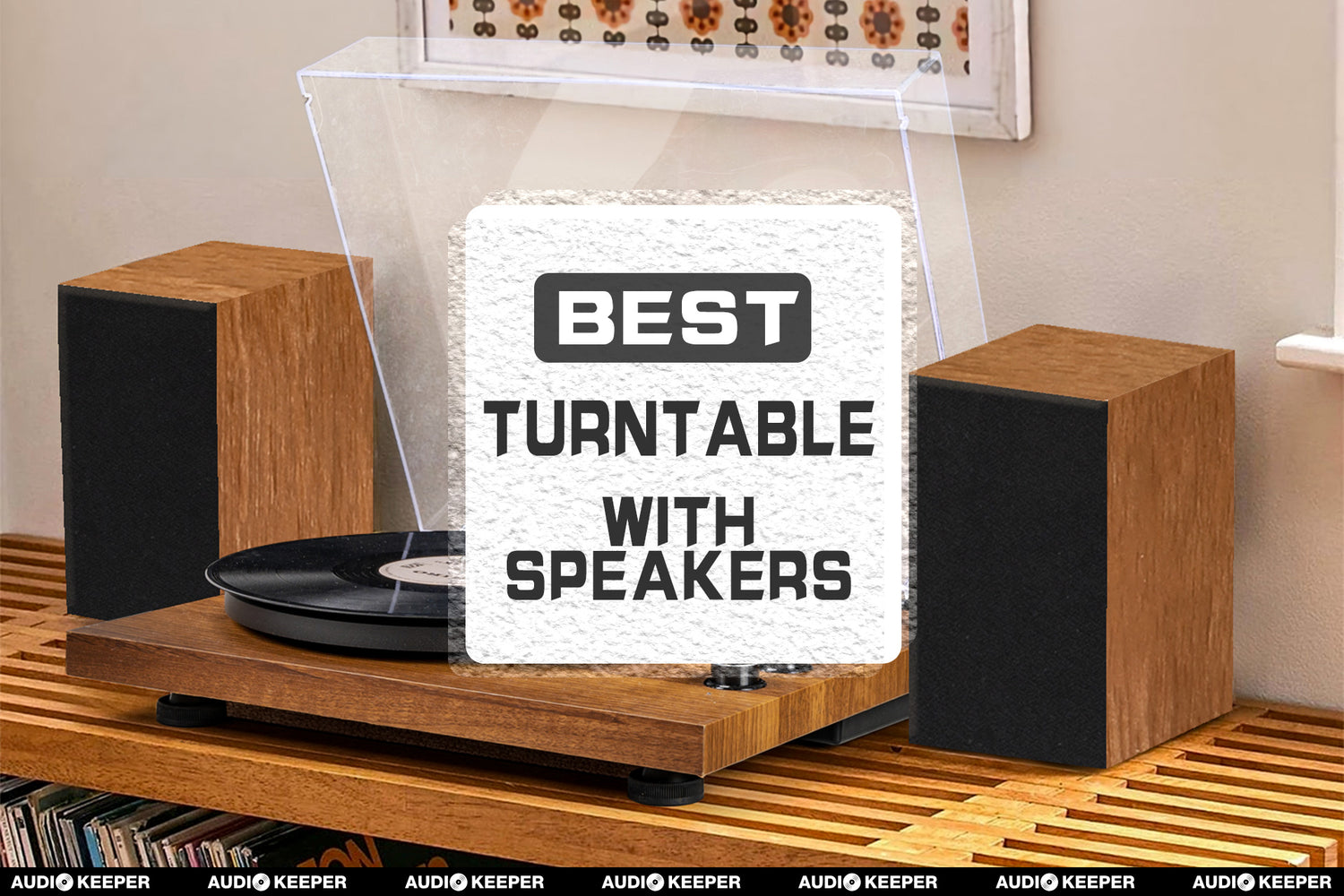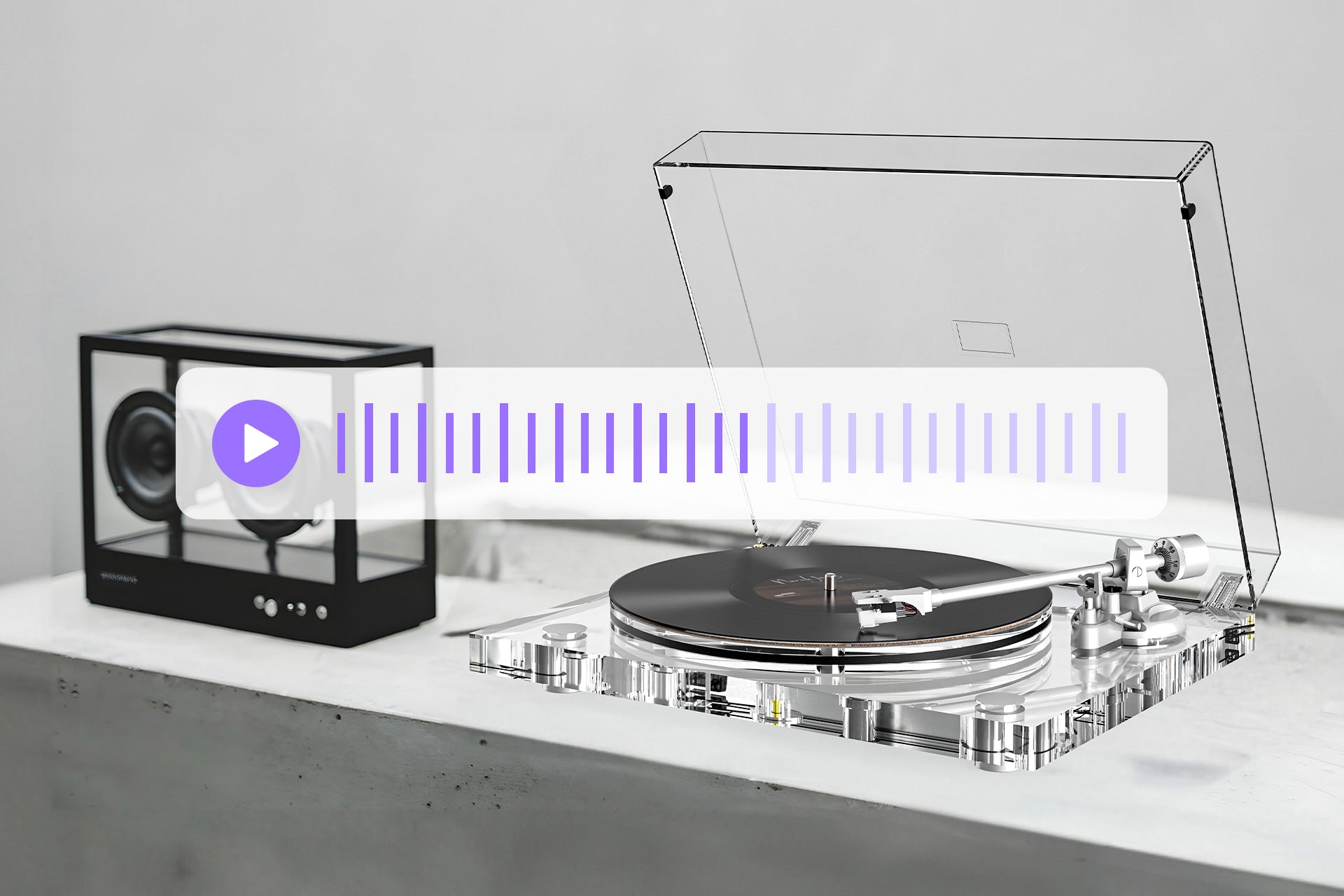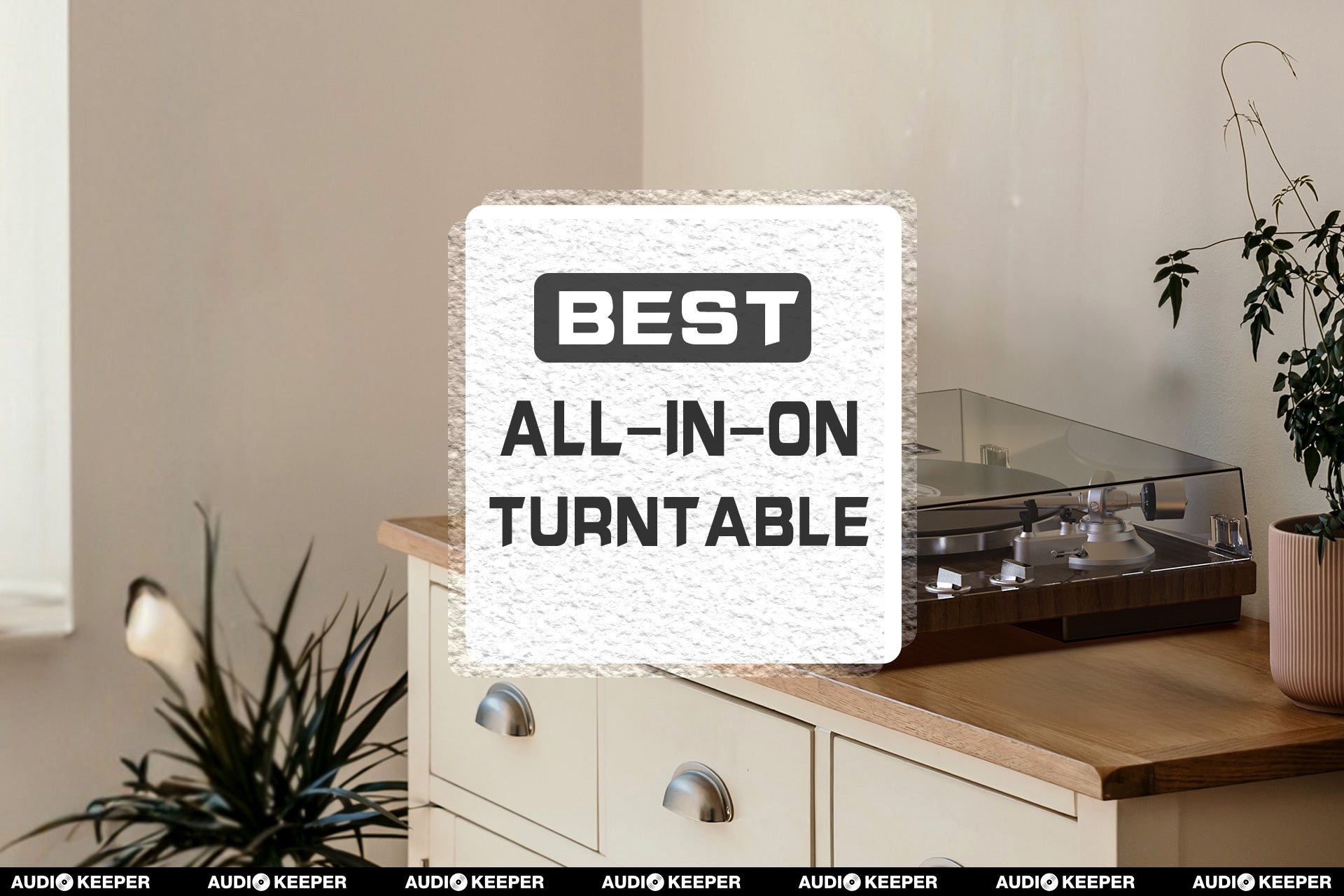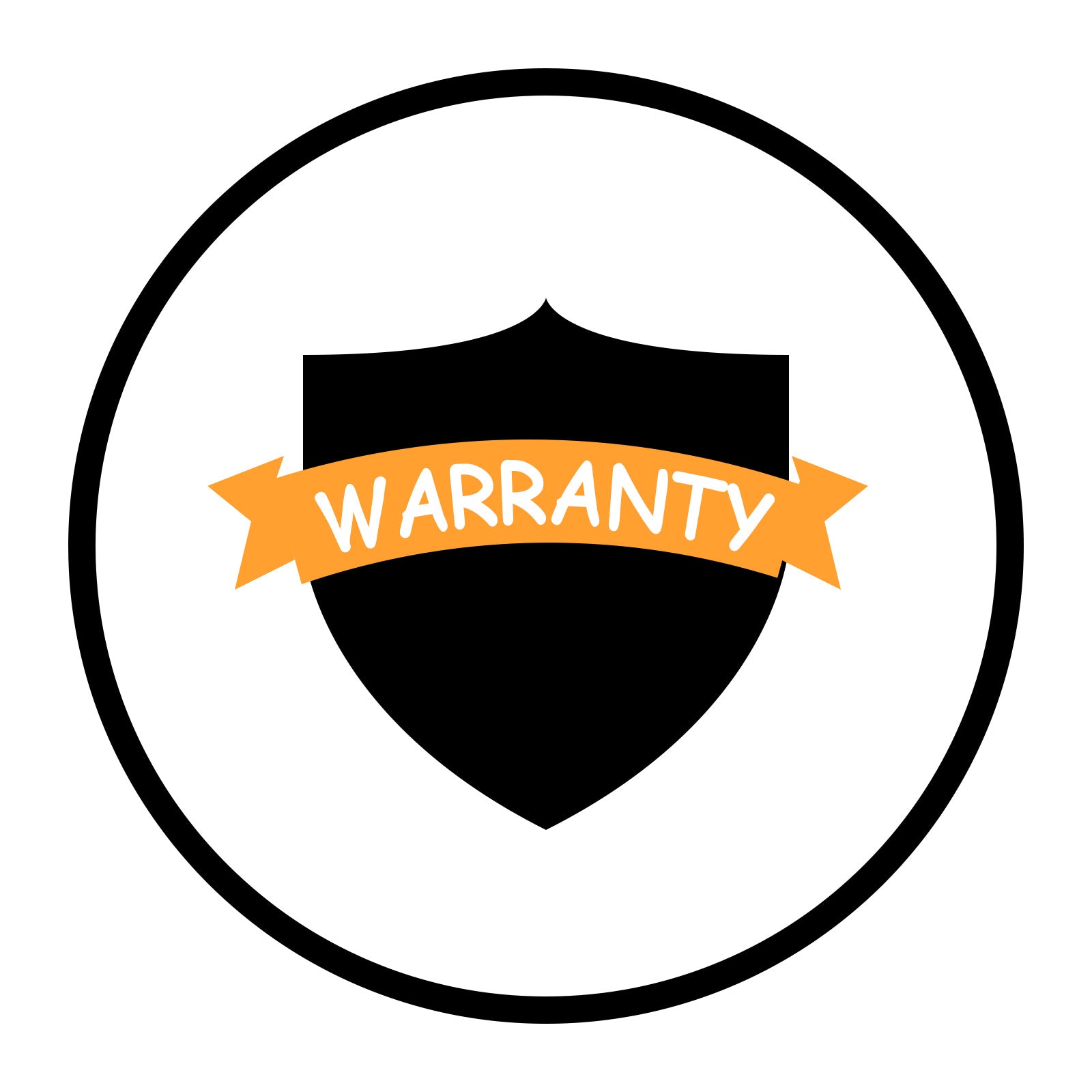Introduction
In an era where digital music reigns supreme, the allure of vinyl records has made a remarkable comeback. For many audiophiles and casual listeners alike, the warm, rich sound of a record player evokes nostalgia and enhances the listening experience. This guide will explore the best record players with external speakers, focusing on options that deliver exceptional sound quality and stylish design. Whether you’re looking for a complete turntable stereo system or just want to upgrade your current setup, this comprehensive guide will help you make informed choices.
Part 1. Understanding the Basics of Record Players with External Speakers
When exploring the world of vinyl, it’s essential to understand how a record player with speakers works. At its core, a turntable translates the grooves of a vinyl record into sound, but to truly enjoy this music, quality speakers are crucial. External speakers for record players can significantly enhance sound clarity, bass response, and overall audio quality. This section will delve into how turntables connect to speakers, the benefits of using external options, and the impact on your home audio experience.
Understanding how turntables connect to speakers is essential for anyone looking to optimize their home audio setup. This section will explore the different connection methods, the benefits of using external speakers, and how these choices impact your overall listening experience.
How Turntables Connect to Speakers

When connecting a turntable to speakers, several factors come into play, including the type of speakers, the connection methods, and the presence of a built-in preamp.
-
Direct Connection: Some turntables have built-in amplifiers, allowing them to connect directly to powered (active) speakers via standard audio cables (usually RCA). This is often the simplest setup, ideal for those who want minimal complexity.
-
Using an Amplifier: For passive speakers, a dedicated amplifier is required. In this case, the turntable connects to the amplifier via RCA cables, and then the amplifier connects to the speakers. This setup provides better sound quality and customization options but requires more equipment and space.
-
Phono Preamp Requirement: Many turntables output a weak signal that needs amplification to reach standard line level. Some amplifiers have built-in phono preamps, while others require an external one. Understanding this requirement ensures you achieve the best sound quality from your records.
Benefits of Using External Speakers
Opting for external speakers can significantly enhance your audio experience in several ways:
-
Improved Sound Quality: External speakers, especially high-end models, typically offer superior sound clarity and depth compared to built-in speakers. They can produce a wider frequency range, providing richer bass and clearer highs that make your music come alive.
-
Better Placement Flexibility: With external speakers, you can position them optimally within your space to achieve the best sound. This includes adjusting their distance from the turntable, angling them for better stereo separation, and placing them in areas where they can create a more immersive listening environment.
-
Tailored Listening Experience: By choosing your speakers, you can customize your audio setup to fit your personal preferences. Whether you prefer warmer sound profiles or crisp, detailed audio, you can select speakers that match your desired listening style.
Impact on Your Home Audio Experience
The connection method and choice of speakers can dramatically impact your overall listening experience:
-
Engagement with Music: When using high-quality external speakers, you’re likely to notice subtleties in your vinyl records that you may have missed with built-in options. This can create a more engaging and emotional connection to the music.
-
Room Acoustics: The quality and placement of your speakers can affect how sound interacts with your room. External speakers allow for greater consideration of room acoustics, enabling you to experiment with placement to achieve optimal sound performance.
-
Long-term Satisfaction: Investing in a solid turntable and high-quality external speakers can lead to a more satisfying and enduring listening experience. As your taste in music evolves, you can upgrade your setup without the need to replace the entire system.
Conclusion
Connecting your turntable to speakers is a fundamental aspect of creating an enjoyable home audio experience. By understanding the various connection methods and the advantages of using external speakers, you can significantly enhance your listening sessions. This investment not only improves sound quality but also allows for greater customization, ultimately leading to a more rewarding and immersive connection to your music.
Part 2. Top Features to Look for in a Turntable with Speakers
When selecting the best record players with external speakers, several key features can elevate your listening experience. First and foremost, consider the build quality of the turntable; a solid construction minimizes vibrations and improves sound fidelity. Additionally, look for models that offer adjustable tracking force, built-in preamps, and connectivity options such as Bluetooth. This section will detail these features and explain why they are essential for a high-quality home audio record player.

When it comes to enjoying vinyl records, not all record players are created equal. Selecting a high-quality home audio record player involves understanding key features that can significantly enhance your listening experience. This section will detail these features and explain their importance in achieving superior sound quality and longevity.
1. Build Quality and Materials
Importance: The overall build quality of a turntable directly impacts its durability and sound performance. A well-constructed turntable minimizes unwanted vibrations that can distort audio.
Key Features:
- Chassis: A solid chassis, often made from wood or heavy plastic, helps reduce resonance. Wood is especially favored for its natural acoustic properties.
- Platter Material: Heavier platters, commonly crafted from materials like glass or acrylic, maintain speed stability and enhance sound fidelity by dampening vibrations.
2. Drive Type: Belt vs. Direct Drive
Importance: The drive mechanism of a turntable affects both its sound quality and maintenance needs.
Key Features:
- Belt Drive: Generally preferred by audiophiles, belt drive systems use a rubber belt to isolate motor noise from the platter, resulting in clearer audio playback. They are particularly beneficial for critical listening.
- Direct Drive: While favored by DJs for quick start-up times and durability, direct drive models have made significant strides in sound quality. Modern designs reduce motor noise, making them suitable for home use as well.
3. Adjustable Tracking Force and Anti-Skate Control
Importance: These adjustments are critical for optimal stylus performance, ensuring it accurately tracks the grooves of the record without causing damage.
Key Features:
- Tracking Force: Adjustable tracking force allows you to set the right amount of pressure the stylus exerts on the record, helping to avoid skipping and excessive wear.
- Anti-Skate Control: This feature counteracts the inward pull on the tonearm, maintaining even pressure across the record’s surface. Proper adjustment can enhance stereo imaging and overall sound clarity.
4. Built-in Preamp
Importance: A built-in preamp simplifies the connection process, enabling you to connect your turntable directly to speakers or an amplifier without needing an external phono stage.
Key Features:
- Switchable Outputs: Look for models that allow you to switch between line and phono outputs. This flexibility enables compatibility with various audio systems and simplifies setup.
5. Connectivity Options
Importance: In a modern audio setup, having versatile connectivity options enhances usability and allows for seamless integration with other devices.
Key Features:
- RCA Outputs: Standard RCA outputs are essential for connecting to most amplifiers and powered speakers.
- USB Connectivity: This feature enables you to digitize your vinyl collection, making it easy to archive and share your favorite records.
- Bluetooth Capability: For those who prefer wireless setups, Bluetooth integration allows you to stream music from other devices, providing additional versatility.
6. Tonearm Design
Importance: The design and quality of the tonearm are crucial for sound quality, influencing how well the stylus tracks the grooves.
Key Features:
- Lightweight Construction: A well-engineered tonearm minimizes tracking error and improves sound accuracy. Materials like carbon fiber are often used for their strength and lightness.
- Adjustable Counterweight: This feature allows you to balance the tonearm correctly, ensuring optimal tracking force for the stylus.
7. Platter Design and Weight
Importance: The platter is the foundation of your turntable and plays a significant role in sound stability and quality.
Key Features:
- Heavy Platter: A heavier platter reduces speed fluctuations, contributing to consistent playback. This helps minimize issues like wow and flutter, ensuring smoother sound reproduction.
- Damped Surfaces: Some platters have damped surfaces that further reduce resonance, enhancing overall audio clarity.
Conclusion
When evaluating a high-quality home audio record player, understanding these essential features is crucial. Each aspect—from build quality and drive type to connectivity options—contributes significantly to the listening experience. By prioritizing these features, you can ensure that your investment in vinyl translates into rich, immersive sound, allowing you to fully appreciate the nuances of your favorite records.
Part 3. Best Turntables with Built-in Speakers vs. External Speakers
While some record players come with built-in speakers, many audiophiles prefer using external speakers for their enhanced sound quality. This section will compare the pros and cons of each option, discussing scenarios where a turntable with speakers may suffice and where investing in external speakers would be more beneficial. We will also touch on speaker types—passive vs. active—and how they can affect your listening experience.
When choosing between a turntable with built-in speakers and one that requires external speakers, understanding the pros and cons of each option is crucial for making an informed decision.
Pros of Turntables with Built-in Speakers
-
Convenience: Turntables with built-in speakers offer a simple, all-in-one solution. They require minimal setup and are perfect for those who want to start listening to vinyl without additional purchases or complex installations.
-
Space-Saving: For individuals with limited space, these compact models take up less room than separate components. They are ideal for smaller living areas, dorm rooms, or casual setups where aesthetics and functionality are key.
-
Portability: Many models are lightweight and portable, allowing you to easily move them around or take them to different locations. This makes them great for parties or gatherings where you want to share your vinyl collection.
Cons of Turntables with Built-in Speakers
-
Sound Quality: While convenient, built-in speakers often lack the audio fidelity found in dedicated external speakers. The sound may be less clear, with limited bass response and dynamic range, which can detract from the overall listening experience.
-
Limited Upgrade Options: When you invest in a turntable with built-in speakers, you’re typically locked into that sound system. If you want to enhance your audio experience later on, your options may be limited.
Pros of Using External Speakers
-
Superior Sound Quality: External speakers, especially high-quality models, can provide a much richer and more immersive sound. They can handle a wider frequency range, resulting in clearer highs and deeper lows, enhancing your enjoyment of vinyl records.
-
Flexibility and Customization: By choosing separate components, you can tailor your audio setup to your specific preferences. Whether you prefer passive speakers powered by an amplifier or active speakers with built-in amplification, the options are vast.
-
Upgrade Potential: With external speakers, you can easily upgrade components as your audio tastes evolve. This means you can start with a basic setup and gradually invest in better speakers or a more powerful amplifier.
Cons of Using External Speakers
-
Complex Setup: A turntable requiring external speakers can involve a more complicated setup process, including additional cables and potential compatibility issues between components. This can be daunting for those new to audio equipment.
-
Higher Initial Investment: While there are affordable options, investing in a quality turntable and external speakers can be more costly than an all-in-one solution. This may not be feasible for everyone, especially beginners.
Speaker Types: Passive vs. Active
In addition to choosing between built-in and external options, understanding the types of speakers available is essential.
-
Passive Speakers: These require an external amplifier to power them. While they often provide better sound quality and more options for customization, they necessitate additional equipment and more complex setups.
-
Active Speakers: These come with built-in amplifiers, making them easier to set up and use right out of the box. They are often more compact and convenient but may limit your options for future upgrades since the amplifier is integrated.
Conclusion
Choosing between a turntable with built-in speakers and one that requires external speakers ultimately depends on your audio needs, space, and budget. If you prioritize convenience and simplicity, a built-in option may suffice. However, for serious audiophiles or those looking to create a high-quality home audio experience, investing in external speakers can be a more beneficial choice, providing superior sound and flexibility. Understanding the differences between passive and active speakers further enhances your ability to tailor your listening setup to suit your preferences.
Part 4. Recommended Turntable Stereo Systems for Vinyl Lovers
For those serious about their vinyl collection, investing in a complete turntable stereo system is a game-changer. This section will review some of the best systems available, highlighting models that excel in both sound quality and design. We’ll discuss various configurations, including those that offer flexibility with additional speakers for record players, making them suitable for different room sizes and acoustic environments.

When setting up a turntable stereo system, configuration plays a crucial role in achieving the best sound quality and overall listening experience. This section will explore various configurations, particularly those that allow for flexibility with additional speakers for record players. These setups can be tailored to suit different room sizes and acoustic environments, ensuring that your vinyl collection sounds its best.
1. All-in-One Systems
Overview: All-in-one systems combine a turntable with built-in speakers and amplifiers, making them an excellent choice for those with limited space or who prefer a simpler setup.
Advantages:
- Space-Efficient: Ideal for small apartments or bedrooms, these systems take up minimal room while still providing decent sound quality.
- Easy Setup: With everything integrated, you can set up your system quickly without worrying about additional components or cables.
Limitations:
- Sound Quality: While convenient, all-in-one systems often sacrifice sound quality for compactness. They may not deliver the richness and clarity found in more elaborate setups.
2. Basic Turntable with Passive Speakers
Overview: A turntable paired with passive speakers and a separate amplifier is a more traditional setup that offers enhanced sound quality and flexibility.
Advantages:
- Sound Performance: This configuration allows for better sound quality since you can choose high-quality speakers and an amplifier that suits your listening preferences.
- Upgrade Potential: You can easily swap out components as your audio needs evolve. For instance, you can start with a basic amplifier and upgrade to a more powerful one later.
Room Suitability: This setup works well in medium to large rooms where sound distribution and quality are prioritized.
3. Turntable with Active Speakers
Overview: Active speakers come with built-in amplifiers, allowing for a more straightforward setup while still providing excellent sound quality.
Advantages:
- Simplified Setup: With fewer components required, you can connect your turntable directly to the active speakers, making it a hassle-free option.
- High Sound Quality: Active speakers are designed to optimize performance, often featuring advanced technologies for improved audio clarity.
Room Suitability: This configuration is versatile and can fit well in various room sizes, making it suitable for both small and larger spaces.
4. Multi-Speaker Systems
Overview: For audiophiles or those with a passion for high-fidelity sound, a multi-speaker system can create a truly immersive listening environment.
Advantages:
- Enhanced Soundstage: By placing multiple speakers around the room, you can achieve a wider soundstage and improved stereo imaging, allowing for a more engaging experience.
- Customization: You can mix and match different speaker types, such as floor-standing, bookshelf, and subwoofers, to create a tailored sound profile that suits your preferences.
Room Suitability: Ideal for larger rooms or dedicated listening spaces where the acoustics can be optimized for multi-speaker configurations.
5. Wireless Speaker Systems
Overview: Modern technology has made wireless speaker systems increasingly popular. These systems can connect via Bluetooth or Wi-Fi, providing flexibility and convenience.
Advantages:
- No Cables: Wireless systems eliminate the need for extensive cabling, making them easier to set up and rearrange.
- Versatile Placement: You can position speakers anywhere within range, allowing for creative setups that enhance your listening experience.
Limitations: Wireless systems may introduce latency or compression that can affect sound quality, so it’s essential to choose high-quality options designed for audiophiles.
Conclusion
When selecting a turntable stereo system, the configuration is key to optimizing sound quality and accommodating your space. From all-in-one systems that prioritize convenience to flexible setups with passive or active speakers, each option offers unique advantages. By understanding your room size and acoustic environment, you can tailor your audio setup to create an enjoyable and immersive vinyl listening experience. Whether you're an audiophile seeking the best sound or a casual listener looking for simplicity, there’s a configuration that will suit your needs.
Part 5. Setting Up Your Turntable with Speakers for Optimal Sound
Once you’ve selected the perfect record player and speakers, the next step is proper setup. This section will provide a step-by-step guide on how to connect your turntable to external speakers effectively, along with tips for placement to achieve the best sound quality. Factors such as room acoustics, speaker distance, and height will be addressed to help you create a listening environment that maximizes your home audio record player’s potential.
Setting up your turntable with external speakers can significantly enhance your listening experience, provided you do it correctly. This section will provide a detailed step-by-step guide on how to connect your turntable to external speakers effectively. Additionally, we’ll cover placement tips to help you achieve the best sound quality by considering factors such as room acoustics, speaker distance, and height.
Step 1: Gather Your Equipment
What You Need:
- Turntable
- External speakers (active or passive)
- Amplifier (if using passive speakers)
- RCA cables
- Phono preamp (if your turntable does not have a built-in one)
- Speaker cables (if using passive speakers)
Step 2: Connect the Turntable to the Phono Preamp (if applicable)
- Identify Outputs: Locate the RCA output jacks on your turntable. Typically, these are color-coded (red for right audio, white or black for left).
- Connect to Preamp: If your turntable has no built-in preamp, connect the RCA cables to the input jacks on your external phono preamp.
Step 3: Connect the Preamp to the Amplifier (if using passive speakers)
- Use RCA Cables: Take another set of RCA cables and connect the output of the phono preamp to the input of your amplifier.
- Amplifier Setup: Ensure your amplifier is plugged in and powered on.
Step 4: Connect the Amplifier to the Speakers
- Speaker Cables: Use speaker cables to connect the amplifier’s output to the speakers. Match the positive (usually red) and negative (black) terminals correctly to maintain phase coherence.
- Positioning: Place your speakers in their intended location, as discussed in the next section.
Step 5: Connect Directly to Active Speakers (if applicable)
If you are using active speakers with built-in amplifiers, simply connect the turntable’s RCA output directly to the active speakers’ input using RCA cables. Ensure that the speakers are powered on and connected to a power source.
Step 6: Set Up the Phono Preamp Output (if applicable)
If your preamp has a switchable output, ensure it is set to the appropriate mode (phono or line) based on your connection type.
Step 7: Test Your Setup
- Power On: Turn on your turntable and speakers (or amplifier).
- Play a Record: Start with a familiar record to evaluate sound quality.
- Adjust Volume: Set the volume to a comfortable level and check for any distortions or issues.
Tips for Placement to Achieve the Best Sound Quality
-
Consider Room Acoustics:
- Soft Furnishings: Rooms with carpets, curtains, and cushions can help absorb sound and reduce echoes. Consider adding these elements to improve acoustics.
- Avoid Hard Surfaces: Minimize reflections from hard surfaces like glass or bare walls. Using acoustic panels can also help.
-
Speaker Distance:
- From Walls: Position speakers at least a foot away from walls to reduce bass build-up and improve clarity.
- Speaker Separation: Aim for speakers to be at least 6-8 feet apart for optimal stereo imaging. This distance creates a balanced soundstage.
-
Speaker Height:
- Ear Level: Place speakers at ear height when seated to ensure direct sound reaches your ears without being diffused.
- Angle: If possible, angle the speakers slightly inward towards the listening position to enhance stereo effects.
-
Experiment with Placement:
- Move Around: Test different placements for both the turntable and speakers to find the best sound. Small adjustments can make a significant difference in audio quality.
- Listening Position: Make sure your main listening position has a clear path to both speakers, avoiding obstructions that can disrupt sound.
Conclusion
Connecting your turntable to external speakers involves several straightforward steps, but achieving the best sound quality requires careful consideration of placement and room acoustics. By following this guide and implementing the suggested tips, you can create a listening environment that maximizes your home audio record player’s potential. Enjoy the rich, immersive experience of your vinyl collection, knowing you’ve set up your system for optimal performance.
Part 6. Caring for Your Turntable and Speakers: Maintenance Tips
To ensure longevity and consistent performance from your turntable and speakers, regular maintenance is crucial. This section will outline essential care practices, including cleaning records, checking stylus condition, and speaker care. By implementing these maintenance tips, you’ll preserve the quality of your sound system, keeping your music playing beautifully for years to come.
Maintaining your turntable and sound system is crucial for ensuring optimal performance and prolonging the lifespan of your equipment. This section will outline essential care practices, including cleaning records, checking stylus condition, and speaker care. By implementing these maintenance tips, you’ll preserve the quality of your sound system, keeping your music playing beautifully for years to come.
1. Cleaning Your Records
Importance: Dust, dirt, and grime can accumulate on your vinyl records, negatively impacting sound quality and causing unnecessary wear on your stylus. Regular cleaning can help preserve both your records and your playback equipment.
Cleaning Methods:
- Dry Cleaning: Use a carbon fiber brush to remove dust from the surface of your records before each play. This method is quick and effective in preventing dirt from scratching the vinyl.
- Wet Cleaning: For deeper cleaning, consider a record cleaning solution and a microfiber cloth or a dedicated record cleaning machine. Apply the solution evenly, and gently wipe in a circular motion to lift more stubborn dirt.
- Storage: Always store records vertically and in a cool, dry place to prevent warping and further dust accumulation. Invest in anti-static inner sleeves to protect the vinyl from static buildup and scratches.
2. Checking Stylus Condition
Importance: The stylus, or needle, is crucial for reading the grooves of your records. A worn or damaged stylus can produce poor sound quality and can even damage your records.
Regular Inspections:
- Visual Check: Periodically inspect the stylus under magnification. Look for signs of wear, such as a rounded tip or any visible debris.
- Cleaning: Use a stylus brush or cleaning solution specifically designed for styluses to gently remove dust and buildup. Always brush from back to front to avoid damaging the delicate tip.
Replacement:
- Guidelines: Most manufacturers recommend replacing the stylus every 500 to 1,000 hours of play. Refer to your stylus manual for specific guidelines.
- Upgrade Options: Consider upgrading to a higher-quality stylus when replacement is necessary. A better stylus can improve sound quality and reduce wear on your records.
3. Caring for Your Speakers
Importance: Proper care for your speakers ensures they deliver high-quality sound and last longer. Speakers can be sensitive to environmental conditions and misuse, so a little attention goes a long way.
Cleaning:
- Dusting: Use a soft, dry cloth or microfiber cloth to dust off the speaker cabinets regularly. Avoid using harsh chemicals that can damage the finish.
- Grille Care: If your speakers have removable grilles, take them off occasionally and clean them gently with a soft brush or cloth. Check for any accumulation of dust in the speaker cones, which can affect sound quality.
Placement and Environment:
- Avoid Heat and Humidity: Keep speakers away from direct sunlight, heat sources, and humid areas to prevent damage. Excessive heat can warp components, while humidity can lead to mildew and speaker deterioration.
- Check Connections: Regularly inspect speaker cables and connections for wear or fraying. Ensure that connections are secure to maintain optimal sound quality.
4. General Turntable Maintenance
Importance: Maintaining your turntable ensures it operates smoothly and consistently. Regular checks can prevent long-term damage.
Belt Maintenance:
- Check for Wear: If you have a belt-drive turntable, inspect the belt for signs of wear or slippage. Replace the belt if it appears frayed or loose.
- Lubrication: Periodically lubricate the motor and bearings according to the manufacturer’s recommendations to ensure smooth operation.
Leveling the Turntable:
- Ensure Stability: Use a bubble level to check that your turntable is perfectly level. An uneven surface can lead to tracking issues and degraded sound quality.
- Isolation Pads: Consider using isolation pads or a dedicated turntable stand to minimize vibrations from the surface it sits on.
Conclusion
Implementing these essential maintenance practices will go a long way in preserving the quality of your turntable and sound system. Regular cleaning of records, checking the stylus condition, and caring for your speakers will help ensure that your music continues to play beautifully for years to come. By taking the time to maintain your equipment, you’ll enjoy a richer and more enjoyable listening experience with your vinyl collection.
Conclusion
The resurgence of vinyl records offers a unique auditory experience that digital formats often lack. By choosing the right record player with external speakers, you can create an exceptional home audio setup that brings your favorite music to life. From understanding the basics to selecting the perfect system, this comprehensive guide has equipped you with the knowledge needed to enhance your vinyl journey. Embrace the art of sound and enjoy the rich, immersive experience that only a quality turntable can provide.









Leave a comment
All comments are moderated before being published.
This site is protected by hCaptcha and the hCaptcha Privacy Policy and Terms of Service apply.